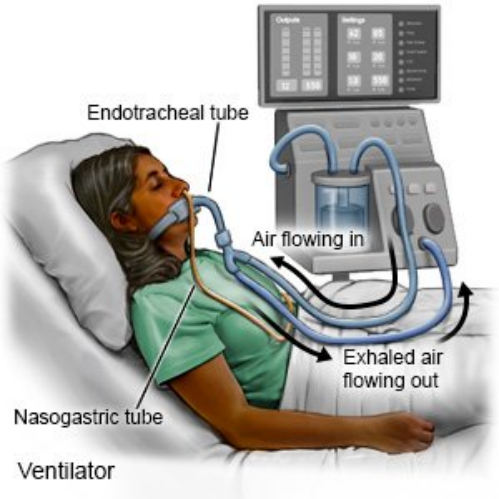A nurse is assessing a client who has fluid overload. Which of the following findings should the nurse expect? (Select all that apply)
Increased respiratory rate.
Increased heart rate
Increased blood pressure
Increased Hematocrit
Increased temperature
Correct Answer : A,B,C
Choice A: Increased Respiratory Rate
Fluid overload, also known as hypervolemia, can lead to an increased respiratory rate. This occurs because the excess fluid in the body can accumulate in the lungs, leading to pulmonary congestion and edema. As a result, the body attempts to compensate by increasing the respiratory rate to improve oxygenation and remove excess carbon dioxide. Normal respiratory rate for adults is typically between 12-20 breaths per minute. An increased respiratory rate above this range can indicate fluid overload.
Choice B: Increased Heart Rate
An increased heart rate, or tachycardia, is another common finding in clients with fluid overload. The heart has to work harder to pump the excess fluid throughout the body, leading to an increased heart rate. This is a compensatory mechanism to maintain adequate cardiac output and tissue perfusion. Normal resting heart rate for adults is between 60-100 beats per minute. A heart rate above this range can be indicative of fluid overload.
Choice C: Increased Blood Pressure
Fluid overload can also result in increased blood pressure, or hypertension. The excess fluid in the bloodstream increases the volume of blood that the heart has to pump, leading to higher pressure within the arteries. This can strain the cardiovascular system and lead to complications if not managed properly. Normal blood pressure is typically around 120/80 mmHg. Blood pressure readings consistently above this range can suggest fluid overload.
Choice D: Increased Hematocrit
Increased hematocrit is not typically associated with fluid overload. Hematocrit is the proportion of red blood cells in the blood. In cases of fluid overload, the hematocrit level is usually decreased due to the dilutional effect of the excess fluid. Therefore, this choice is incorrect.
Choice E: Increased Temperature
Increased temperature is not a common finding in fluid overload. Fever or elevated body temperature is more commonly associated with infections or inflammatory conditions. Fluid overload does not typically cause an increase in body temperature. Therefore, this choice is incorrect.
Free Nursing Test Bank
- Free Pharmacology Quiz 1
- Free Medical-Surgical Quiz 2
- Free Fundamentals Quiz 3
- Free Maternal-Newborn Quiz 4
- Free Anatomy and Physiology Quiz 5
- Free Obstetrics and Pediatrics Quiz 6
- Free Fluid and Electrolytes Quiz 7
- Free Community Health Quiz 8
- Free Promoting Health across the Lifespan Quiz 9
- Free Multidimensional Care Quiz 10
View Related questions
Correct Answer is ["A","C","D","E"]
Explanation
Choice A Reason:
Having suction equipment at the bedside is crucial for a client with status epilepticus. During a seizure, there is a risk of aspiration due to excessive salivation or vomiting. Suction equipment allows the nurse to quickly clear the airway, preventing aspiration and ensuring the client can breathe properly. This precaution is essential to maintain the client’s airway and prevent complications such as aspiration pneumonia.
Choice B Reason:
Continuous sedation is not typically a standard precaution for all clients with status epilepticus. While sedation may be necessary in some cases to control seizures, it is not a universal precaution. The primary goal is to stop the seizure activity and stabilize the client. Continuous sedation may be used in specific situations under close medical supervision, but it is not a general precaution that nurses implement for all clients with status epilepticus.
Choice C Reason:
Padding the side rails of the bed is an important precaution to prevent injury during a seizure. Clients experiencing seizures may have uncontrolled movements, which can lead to injury if they hit the hard surfaces of the bed. Padded side rails help to cushion these impacts, reducing the risk of bruises, cuts, or fractures. This precaution is essential for ensuring the client’s safety during seizure activity.
Choice D Reason:
Keeping the bed in a low position is another important safety measure. If a client with status epilepticus were to fall out of bed during a seizure, the lower height reduces the risk of serious injury. This precaution helps to minimize the impact of any potential falls, ensuring the client’s safety. It is a simple yet effective measure to prevent harm during seizure episodes.
Choice E Reason:
Establishing intravenous (IV) access is critical for a client with status epilepticus. IV access allows for the rapid administration of medications needed to control seizures and manage the client’s condition. In an emergency, quick access to the bloodstream is essential for delivering life-saving treatments. This precaution ensures that the medical team can promptly and effectively intervene to stop the seizure activity.
Correct Answer is D
Explanation
Choice A Reason:
Malfunction of the alarm button is unlikely to be the cause of increased peak airway pressure. The alarm is designed to alert the nurse to a problem with the ventilator or the patient’s airway, not to malfunction itself. Therefore, this is not the first thing the nurse should assess.
Choice B Reason:
A cut or slice in the tubing from the ventilator could cause a loss of pressure or air leak, but it would not typically result in increased peak airway pressure. Instead, it would likely cause a decrease in pressure and potentially trigger a different alarm.
Choice C Reason:
Higher than normal endotracheal cuff pressure can contribute to increased peak airway pressure. However, it is not the most immediate concern compared to a kink in the tubing, which can completely obstruct airflow and rapidly compromise the patient’s ventilation.
Choice D Reason:
A kink in the ventilator tubing is a common and immediate cause of increased peak airway pressure. It obstructs the flow of air, leading to a buildup of pressure in the system. This is the first thing the nurse should assess and correct to ensure the patient is receiving adequate ventilation.

